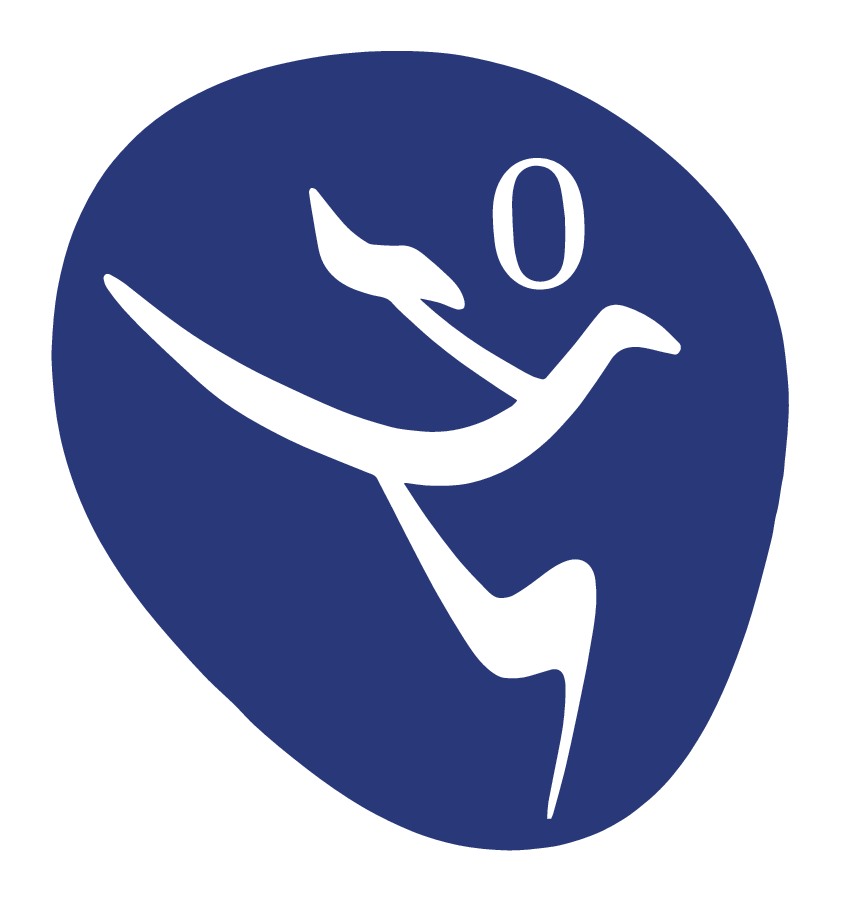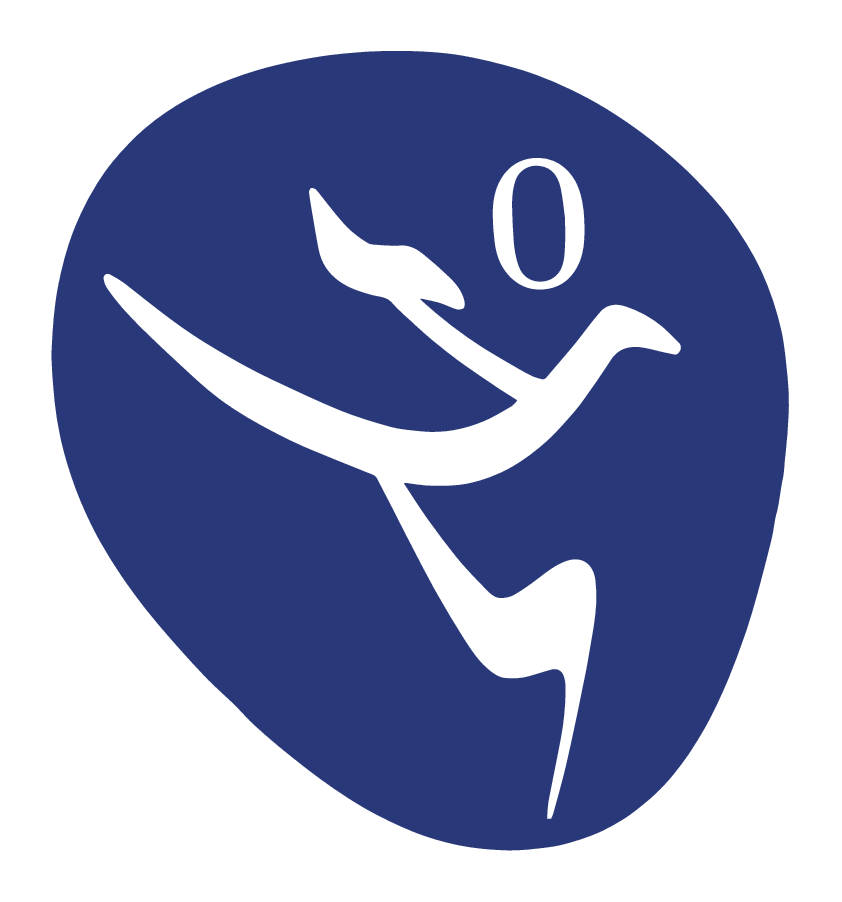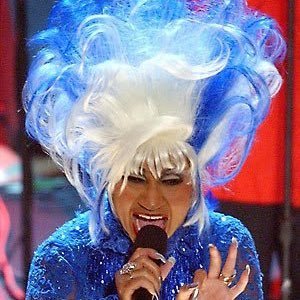"How do you write down how to dance?"
A certain type of person will find themselves asking this question after their first couple of dance lessons. They'll take out one of their notebooks and start writing all the steps and moves and figures they learned in class, spending an hour writing it all out in detail. Then, a few days later, they'll look back at the notes and find that they are mostly useless. Unless they are extremely skilled at free handing the human body or have experience with technical drawing, the diagrams will be a mess, acting more as reminders than records of what they learned, and the descriptions of the moves being overly wordy to the point of incomprehensibility.
What many have come to find, myself included, is that writing down anything about dancing is difficult, especially if you are learning the dance at the same time. Combined with the ease of recording the demonstration and recap of the class that instructors typically provide, it's far easier to rewatch the videos than it is to write down anything yourself. At least, that has been my experiences and the experiences of many others I have talked to about trying to write down how to dance.
I've picked up and abandoned this question more times than I can remember though, writing down and organizing notes, experimenting with my own custom notations and diagrams, exploring existing ones like Labanotation, and just generally getting no where with it over the last decade or so of my social dancing life. I wouldn't say that my notes has ever helped me much in learning how to social dance yet, but it's certainly occupied my interest, easily in the top five of things I like to zone out out thinking about in the shower.
What this blog post is about is how I finally made some progress on this question, found a new kind of dance science in the process, and how I plan to use this science to increase the number and skill of social dancers across the world.
About two years ago, I made another another serious go at writing down dance, really trying to record and understand how Sensual Bachata worked in particular. When I first started trying to write down how to dance, I found myself wondering whether 3D modeling software could be used to create better diagrams and notes about dancing. I put the thought away then, thinking that 3D modeling software and animation was too hard to learn, and that it would be too much work to make anything all that useful. But, I was tired of failing at producing anything all that useful with my dance notes and wanted to try something new, so I hired a private tutor to teach me how to use Blender, a free and open source 3D modeling software.
And I was right! It is way too hard to create a model and animate a dance from scratch, holy shit, super tough. My tutor was wonderful and I was able to make some interesting stuff in blender and generally I learned a lot about how 3D software works. I am super proud of this clock doing a body roll I made from scratch, it only took me about ten hours to learn how to do.
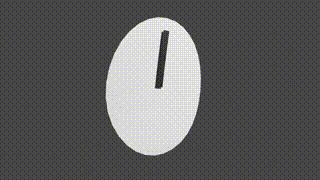
The process of learning how key frames, skeletons, root positions and ideas in animation started to change how I thought about dancing, both in terms of how I wanted to try and write about it, but also more generally, about how I think about dancing in the abstract. Here's the first video I made of two people "dancing".
Something nice about Blender and 3D animation software is that it lets you move the camera around and recreate the position from any angle you might want at any moment in time. Below is a contact sheet I produced of the movie at one point, made using a Blender plugin I threw together with ChatGPT and put online.
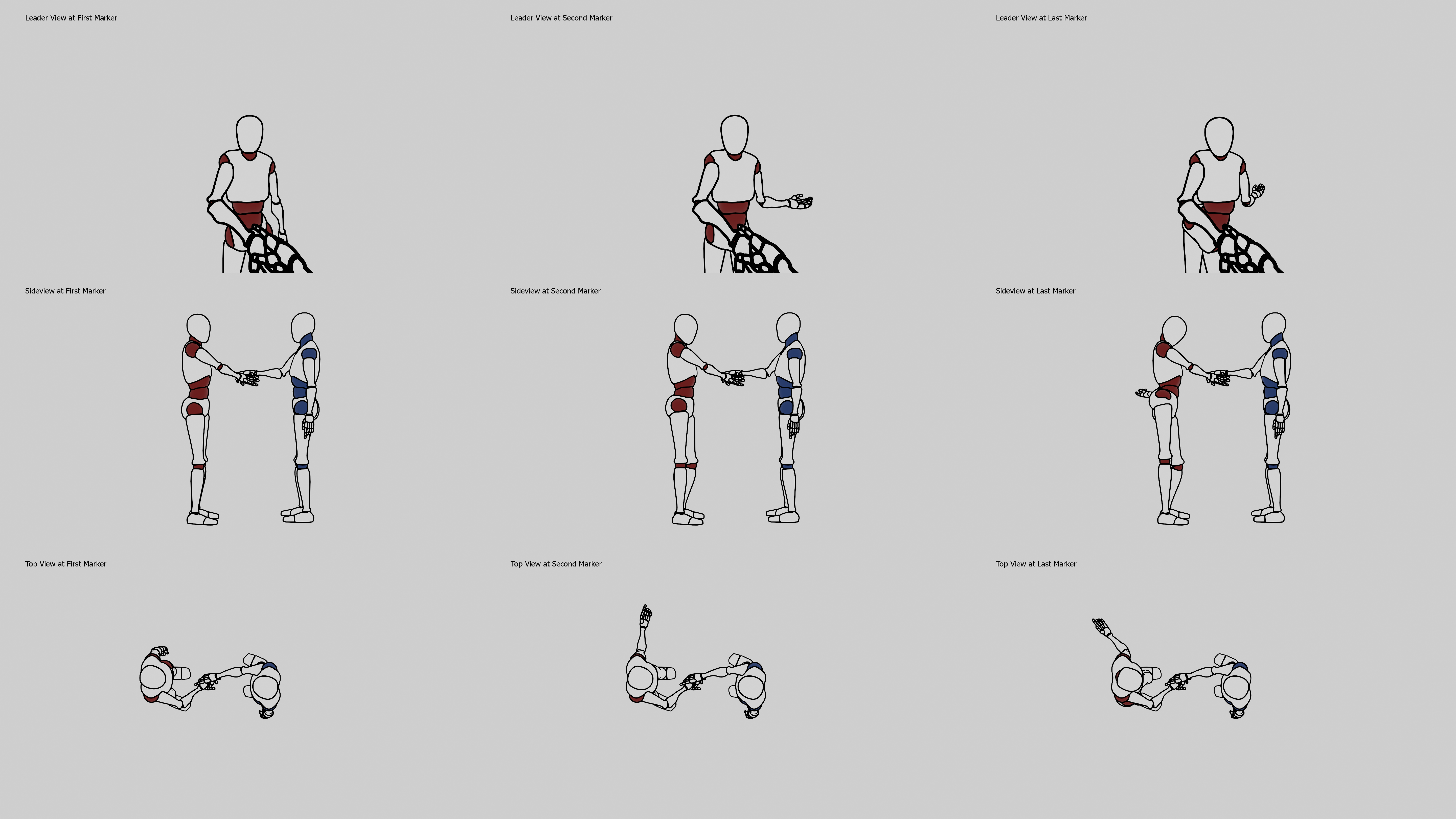
The most concrete thing that came out of those lessons was me being able to put together a riddle for other dancers. I was able to convey a complicated position clearly without having to resort to just taking a picture of me doing it with a friend. As far as the riddle goes, some friends and I enjoyed coming up with it and solving it, there's at least two different ways to get out of this position that could be done in a dance without seeming too awkward.
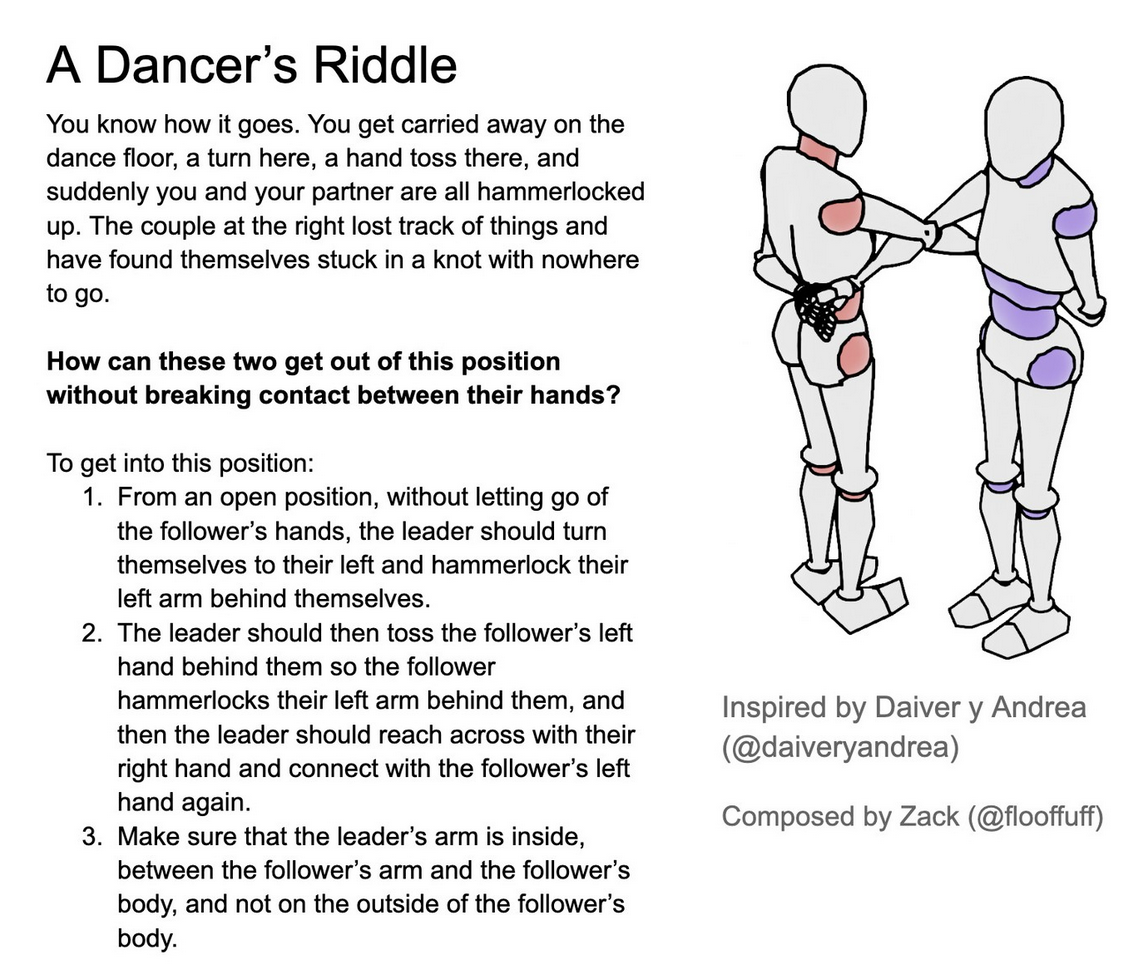
Messing around with the animation software also helped me explore how the position and poses of two people can be written down and characterized. In particular, around the fall of last year I figured out and proved to myself that there are only 15 ways for two people to connect through only their hands, which was very surprising and interesting to me. Some of them can be seen below, another image I produced in Blender.
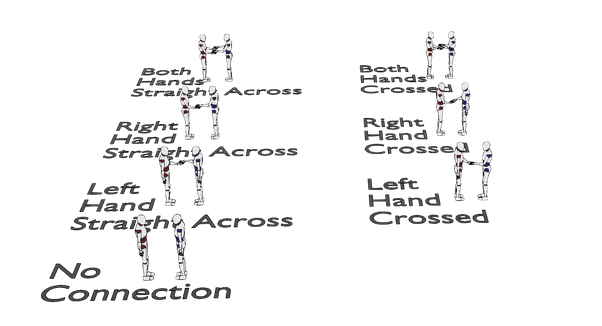
Right about here is where I stopped focusing on 3D modeling and animation and really dove into researching what was going on with these 15 hand holds. I have done a lot of reading and thinking about dancing and I have taken many workshops about many different dances, from beginner to advanced, talked with dance instructors privately often, and nobody had ever mentioned that there were exactly 15 ways to connect through only the hands. My first dance instructor, may he rest in peace, told me that there was only 8 ways to hold hands and nobody since then had ever really talked about it since then. So, finding something new that nobody had ever mentioned to me before really got my interest.
The 15 different ways to connect through only the hands between two dancers are:
- No connection between their hands
- Lead’s left hand straight across
- Lead’s right hand straight across
- Both hands straight across
- Lead’s left hand crossed over
- Lead’s right hand crossed over
- Both hands crossed over
- Lead’s left hand holding both of follower’s hands
- Lead’s right hand holding both of follower’s hands
- Follow’s left hand holding both of lead’s hands
- Follow’s right hand holding both of lead’s hands
- Lead holding own hands
- Follower holding own hands
- Both holding own hands
- All holding all hands
For me when I dance, the first 7 of these are pretty common, 8 through 11 happen only briefly during a transition usually, and then 12 through 15 are weird enough that it took me a lot of thinking to find examples. When I first started thinking about this, I found the first 7 pretty quickly, and then I spent a couple weeks mulling over the question of how many ways there were to connect only through the hands. I got up to 8 then 12 then 14, then finally 15.
The question then became how do I know there aren't any more? How do I know there are only exactly 15, why not 16 or 20 or a 100 or a 1000? One of the problems I had had in the past with creating my own custom notation was writing down where the arms where and how they were connecting with the other person. I couldn't ever find some way of doing it that was able to represent what we were learning in class, it felt like I was always finding something I couldn't represent on paper pretty quickly. So, it felt like I would wake up one day and just find the 16th way to connect through the hands and then I would have to start all over again.
What finally convinced was realizing I could use a little bit of math to prove it directly. If you take the set of the leader’s left hand, the leader’s right hand, the follower’s left hand, and the follower’s right hand, and consider that a particular way of connecting through the hands is a partition of that set, then we know that there are 15 different ways to partition a set of 4 elements. This is called the Bell number for a set of a certain size and it counts the number of possible partitions of a set.
Below is this represented in the abstract, via a Hasse Diagram, illustrated by Wikipedia user Watchduck.
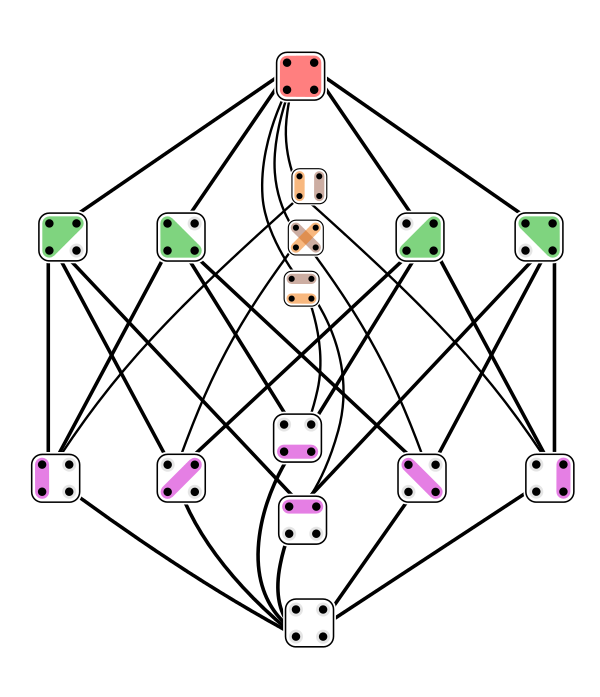
All positions that involve two dancers can be described as falling into one of these 15 categories. From every possible position, if the dancers move, rotate and bend their bodies without ever changing the way their hands connect, they can always get back to one of the 15 original positions. Likewise, there is no amount of moving around, rotating, or bending that can turn one of these positions from one hand hold to another hand hold, provided that the hands are never let go of and no new connections are made. Other parts of the body can come into contact as well, but no matter what the position will always fall into one of these 15 categories.
So, through some combinatorics and topology I was able to prove to myself that the 15 ways were all that existed and that I had finally found them all. There's more to be said about the 15 ways, and I'll write that up later, but for this post, I wanted to describe them because they are what convinced me to really focus on this dance research.
What these do is let is characterize dance positions and study them in the abstract way more than I had ever done before with dancing. For example, the next question one might ask is how many different and unique hammerlocked positions are there? Let's say that a hammerlocked position is one where at least one of the two dancers has at least one of their arms behind their back, with an example of how to get into a simple one seen in this video.
We can start by thinking about how many different possible hammerlocks there are. There are two dancers, each with two arms, so there are four arms to consider here. Each arm could be hammerlocked or not, so there are 2*2*2*2 = 2^4 = 16 possible different hammerlocks. So, there are 15 different ways of connecting through the hands, and 16 possible sets of hammerlocked arms, so there are 15*16 = 240 different possible positions that two dancers can be in that are hammerlocked.
A friend and I experimented with some of these and found that some positions are impossible. For example, suppose that the lead is holding both of the follower's hands in one of lead's hands. If the follower tried to hammerlock both of their arms, it would break the connection. The follower's left hand would be at their right hip, and the follower's right hand would be at their left hip, and it wouldn't be possible for the lead to hold both of the follower's hands in one of their hands. So, some of the 240 possible combinations wouldn't be possible.
To see what this looked like I wrote a Python program to calculate and categorize all the possible handholds. It created the following table.
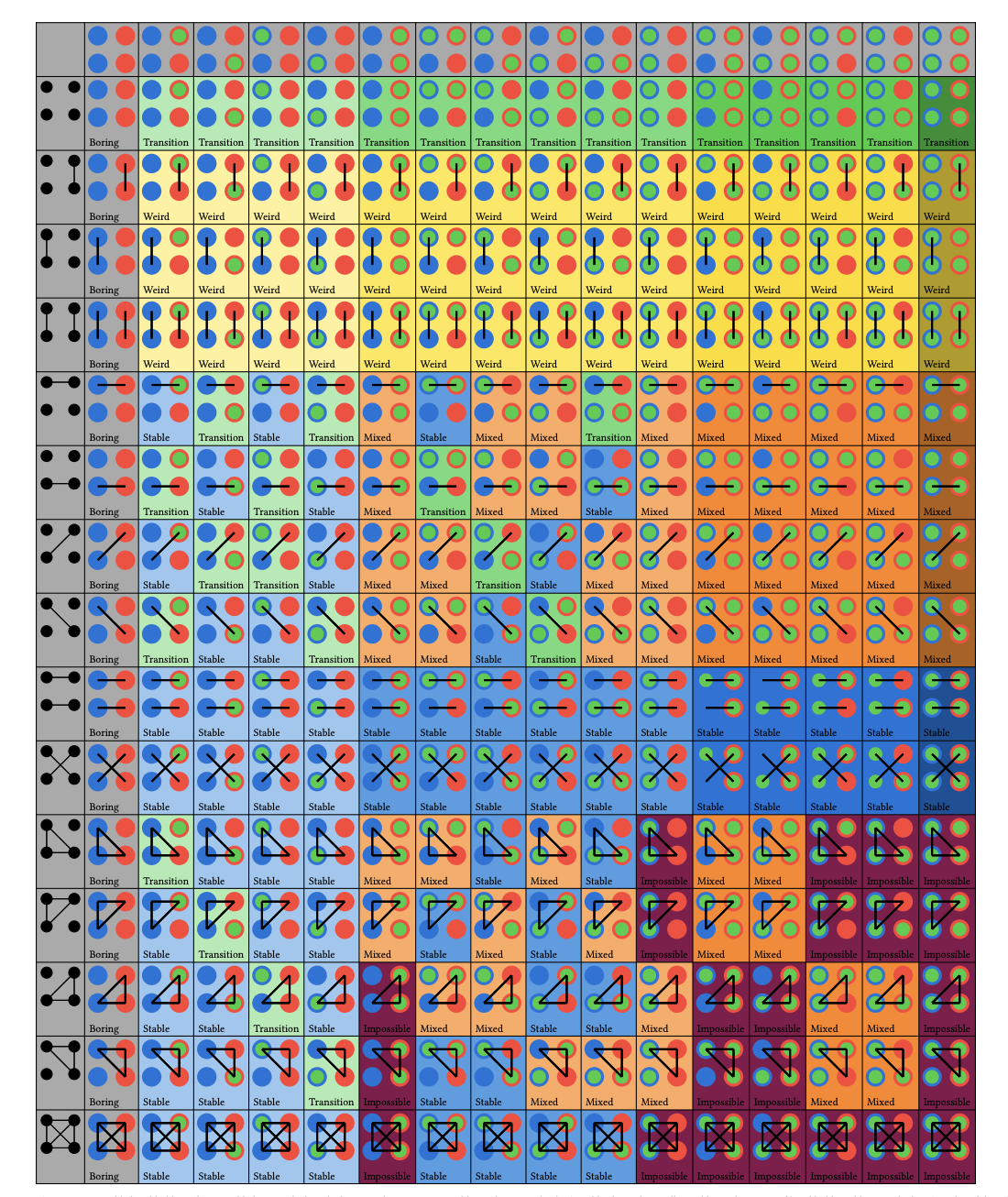
The color of the cell indicates the type of hammer lock. The types and colors are as follows:
- Boring (Gray, 15 total): No hammer lock
- Weird (Yellow, 45 total): Weird hammer lock (somebody holding just their own hands)
- Impossible (Maroon, 23 total): Impossible hammer lock (a person’s hand needs to be in two places at once)
- Stable (Blue, 70 total): Every hand that is hammer locked is connected to the other person’s hand
- Transition (Green, 31 total): Every hand that is hammer locked is not connected to the other person’s hand
- Mixed (Orange, 56 total): Some hands that are hammer locked are connected to the other person’s hand, and some are not
Broken down by number of arms that are hammerlocked in a normal configuration:
- 0 arm(s) hammerlock: 0 normal from 0 stable, 0 mixed, and 0 transition hammerlocks.
- 1 arm(s) hammerlock: 48 normal from 32 stable, 0 mixed, and 16 transition hammerlocks.
- 2 arm(s) hammerlock: 66 normal from 28 stable, 28 mixed, and 10 transition hammerlocks.
- 3 arm(s) hammerlock: 36 normal from 8 stable, 24 mixed, and 4 transition hammerlocks.
- 4 arm(s) hammerlock: 7 normal from 2 stable, 4 mixed, and 1 transition hammerlocks.
If we take the stable, mixed and transition hammerlocks to be considered normal, leaving out the boring, weird and impossible, ones, then we have 157 possible hammerlocks. The ones people are most likely to encounter in the dance floor are the hammerlocks are one with one or two arms hammerlocked. But, you never know, I've had a lot of fun messing around with three arms hammerlocked, and a good challenge of trying to do literally anything with all four arms hammerlocked. I didn't expect that there would be so many different ways or that there would be so many ones that were just weird of impossible.
Moreover, to me, this was all very new while feeling also feeling very fundamental. As you might imagine for someone who spent a lot of time over the last few years working on this sort of thing, I've looked pretty hard for anyone else who has worked on this sort of thing and I cannot find anyone. Like I've said, I've danced and thought about dancing for a long time now, and this sort of thing has never come up.
For me personally, knowing about these different ways of categorizing positions, and having a way of calculating out the possibilities without having to test everything has definitely improved my dancing. I've been told often that I am a unique and creative leader when social dancing, and I think part of it is that I use these principles and others to make up my own moves and patterns on the fly. For some people, I understand that the math and abstractions I used might be a turn off or that all the thinking might feel like it goes against the spirit of why they dance. I don't disagree with them, I do think that for them this is not the right approach.
For me, and I suspect many other people, this level of abstraction does help with understanding and learning how to dance. What I struggled with when I first started learning was how big dancing felt and how slowly I was learning it. For people like myself who are detail oriented, it's hard to learn everything at once, to know what to focus on when first learning how to dance. Moreover, after a while, it felt like as soon as I learned one move, it took the place of another that I simply forgot that I knew how to do.
My desire for writing down how to dance is to help myself and others learn and remember how to dance easier and faster. I started dancing again two years ago after a long break, with the pandemic shutting down social dancing for a while and also with me breaking an ankle and needing to recover from that. When I came back to dancing, in many ways, it felt like I was relearning everything all over again, with a different body after the recovery from my injury and with a dusty mind that had forgotten all the moves I had learned before. When I started trying to record Bachata Sensual, I was motivated by that desire to not lose all of the dance knowledge I had worked so hard to gain.
After all this experimenting and research, I decided to make Zack's Dance Lab, a website where I can post publicly about the research I have been doing. I feel like I know enough about how to write down dancing now that I can talk about the specifics of dancing without having to resort to filming a thousand videos about it. Dancing has brought me so much joy in my life, and changed it for the better in countless ways, so I would like to try and give something back to the community if I can.
My mission is to increase the number and skill of social dancers across the world. I think I know enough about writing down how to dance now that I can produce things that will help people learn how to dance faster and easier. I have a lot of ideas about how to do this, and I am excited to share them with the world. To get updates about what the lab is up to can sign up for the newsletter below.
The first project that I have planned is to create a glossary of Zouk terms. It's a different type of research than the above, but it's dance research all the same and it's something that I and others would find interesting and useful. I've collected many different terms from many different sources and I think it will be one of the most comprehensive glossaries of Zouk out there presently.
So with all, that bye-bye for now!
P.S. The logo for the lab was designed by a friend of mine and I feel free lucky to have it, as it represents the lab so well. The dancing character in the logo is a modified Aleph Null. In set theory, Aleph numbers is used to represent the cardinality (or size) of infinite sets that are well ordered. So, the logo is about how to count and categorize the infinite ways that two people can dance together and I find that to be very beautiful.

